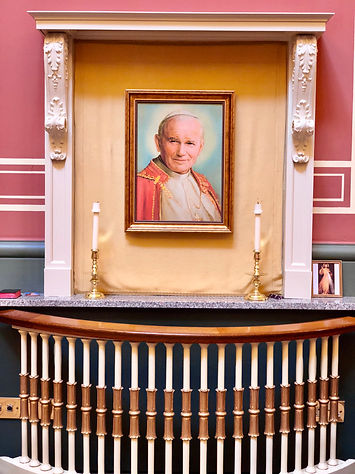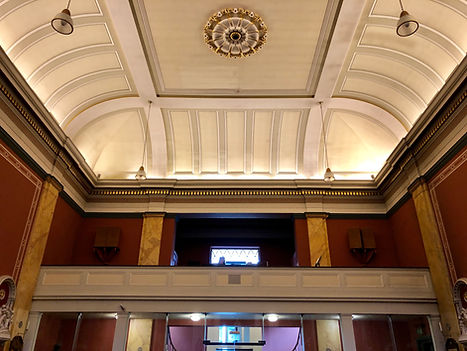History of St Francis Xavier's Church
In pre-Reformation times, the Broad Street site was occupied by the Convent of St. Catherine. A silver seal, dedicated to her was found during excavations made in 1801. During the 18th century, the house and gardens on the site were owned by two maiden sisters of Sir William Etheridge, a devout Lancashire Catholic and the upper rooms converted for use as a chapel, under the jurisdiction of the Jesuit order. Even at the end of the 18th century Catholic worship was still a hazardous undertaking and it is said that the Franciscans would say Mass in secret in a garret in Church Street, but in 1792 a modest church was built which served the Catholic community for 40 years.
In 1829 the Catholic Emancipation Bill was passed which allowed Catholics the freedom to worship publicly and plans for a new, larger Catholic church were drawn up. The foundation stone was laid on 19th September, 1837 during a ceremony ‘which was remarkable for the broad ecumenical disposition of those taking part’ and completed two years later. The new Queen Victoria sent her representative, the High Sheriff, Thomas Mornington, the first time for three hundred years that the monarch’s representative had graced a Catholic function.
The Society of Jesus (the Jesuits) paid for the church which was dedicated to St. Francis Xavier, their greatest missionary. He was born into a wealthy Spanish family in 1506 and had a very comfortable upbringing but a serious illness while he was still young, changed his life completely.


He became a missionary priest of the Society of Jesus, preaching throughout France and Spain and then venturing to the Far East, including Japan. He died on the island of Shangchwan off the coast of China and was canonised by Pope Gregory XV in 1622.
Jesuit Fathers served the church until 1857, when it passed into the pastoral care of the Benedictines.
The general decorations of the church were designed and carried out by Joseph Hanson of Preston.
The building is of the Doric order of Greek architecture and the façade is based on the Treasury of the Athenians at Delphi.
At the apex of the portico is a large, plain stone cross, newly gilded. The interior is that of a ‘hall church’ with an elegant coved ceiling and three square panels. The easternmost panel is replaced by a lantern dome, providing the only source of natural light. The church is 117 feet long, 42 feet wide and the walls are 36 feet high. The dome rises to 60 feet and is decorated with 390 gold stars on a blue background, inspired by the ceiling of the mausoleum of the Christian empress Galla Placidia in Ravenna.


A pair of Ionic columns supports the east end of the church and in the centre stands the marble High Altar and gilded Tabernacle. This is a replica of the tabernacle in the Chapel of the Blessed Sacrament of St. Peter’s in Rome. There are two inscriptions: round the base are, in Latin, ‘My flesh is food indeed’ and round the centre ‘Behold the bread of Angels. Truly the Bread of the Children of Men. O Good Shepherd, Thou art our Feast, our support. Jesus have mercy on us.’
The six magnificent candlesticks were the gift of Robert Plowden of Rotherwas and the frescoes on either side of the Sanctuary are of St Francis Xavier and the Blessed Virgin Mary.
Gracing the Tabernacle are relics of: (from l to r) The Venerable Bede, St Francis Xavier, Pope Pius X and St Francis de Sales and St Jane de Chantal. The four statues ringing the sanctuary are the Sacred Heart, St Peter, St Joseph and the Blessed Virgin Mary with the Child Jesus.

The sanctuary lamp was given by Mrs Isabella Rogers who was sacristan to the Church for many years.
To the right of the main altar is the Shrine to St John Kemble. Born in 1599, in the Parish of St Weonards, he became a priest and imprisoned for his beliefs at the time of ‘Popish Plot’. He was hanged on Widemarsh Common in Hereford and his preserved hand lies in the reliquary while the rest of his remains are buried in Welsh Newton churchyard.


Recently commissioned and erected is a Shrine to St John Paul II. Members of the Polish congregation of SFX inaugurated the commemoration when Pope John Paul II was canonised and generous fund raising made the Shrine possible.


Lining the walls are the Stations of the Cross. These were modelled from designs which were first exhibited by a Belgian artist at the Great Exhibition of 1851.
Above the entrance to the Church is the choir and organ loft. The original organ was donated in 1850 and in 1889 the instrument enhanced. Edward Elgar played in the church many times but eventually the organ was damaged beyond repair and it was replaced by a new digital organ.

Through the generosity of Mr John Lambe the entire church was restored for the Jubilee of 1889. Unfortunately, by the 1980’s the Church was in a dilapidated state and the roof had to be repaired to the tune of £90,000. By 1995 the building’s condition was so bad the Archdiocese of Cardiff put it up for sale. It was felt that the refurbishment and restoration was unrealistic and the building of a new Church and presbytery on a different site would be a better option.

At this point, a group of parishioners: ‘The Friends of St Francis Xavier’ was formed especially as there were no realistic offers to buy it.
The Parish applied for funding and successfully achieved financial support from English Heritage and the National Lottery to repair the roof and walls.
Further fundraising enabled the internal restoration to be complete and the Church re-opened in December 2003, commemorated in the marble plaque in the narthex.
The Parish Hall was restored with the help of many fundraising events and hard work on behalf of the parishioners.
There is a thriving congregation at St Francis Xavier’s and every attempt is made to keep the building open for prayer and visitors throughout the week.

